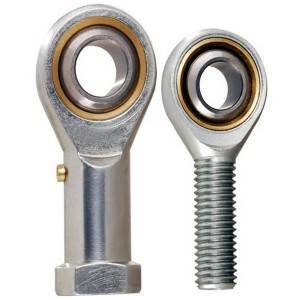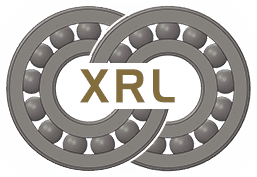Ball joint bearings are essential components in various mechanical systems, providing pivotal connections that allow for smooth movement in multiple directions. Whether used in automotive suspensions, industrial machinery, or agricultural equipment, ball joint bearings enable pivotal motion, ensuring mechanical stability and reducing wear and tear on components. Like any mechanical part, regular maintenance is crucial to extending the lifespan of ball joint bearings and ensuring optimal performance.
At Xinri Bearing, we specialize in producing high-quality bearings, including ball joint bearings, that are designed to deliver durability, reliability, and long-lasting performance. In this article, we’ll explore key maintenance tips to keep your ball joint bearings in top condition, preventing premature failure and maximizing their efficiency.

Why Maintenance of Ball Joint Bearings is Important
Ball joint bearings are subject to significant stress and motion, making them vulnerable to wear and tear over time. Without proper maintenance, issues such as corrosion, friction, and misalignment can occur, leading to costly repairs, equipment breakdowns, or even safety hazards. Regular maintenance helps in:
- Preventing wear: Ensuring the bearing is properly lubricated reduces friction and wear.
- Extending lifespan: Routine inspection and care help prolong the life of the bearings.
- Maintaining performance: Well-maintained bearings ensure smooth and precise movement, which is crucial for the functioning of the entire system.
- Reducing downtime: Catching potential problems early can prevent unexpected breakdowns and costly downtime.
Here are several key tips for maintaining ball joint bearings and ensuring their optimal function over time.
1. Regular Inspection
The first step in maintaining ball joint bearings is performing regular visual inspections. Look for signs of wear, corrosion, or damage to the bearing housing, seals, and surrounding components. Checking the condition of the bearing is essential for spotting early signs of trouble, such as:
- Rust or corrosion: This may indicate exposure to moisture or chemicals that can damage the bearing.
- Loose joints: If the ball joint feels loose or moves excessively, it may indicate that the bearing is worn out and needs replacement.
- Excessive play or wobbling: This could be a sign of bearing misalignment or a lack of lubrication.
- Cracked or torn seals: Damaged seals can allow dirt, debris, and moisture to enter the bearing, leading to premature failure.
At Xinri Bearing, we recommend regular inspections as part of your preventative maintenance schedule to catch potential problems before they become serious.
2. Proper Lubrication
Lubrication is one of the most important aspects of ball joint bearing maintenance. The primary function of lubrication is to reduce friction between moving parts, thereby minimizing wear and extending the life of the bearing. Without proper lubrication, the bearing’s surface can become dry, leading to excessive friction, heat buildup, and eventually, failure.
Here are some lubrication tips to follow:
- Use the right lubricant: Always use a lubricant that is suitable for your specific ball joint bearing. The type of lubricant can vary depending on the application, temperature, load, and environmental factors. Grease is commonly used in ball joint bearings for its ability to stick to surfaces and resist washout in wet conditions.
- Lubricate regularly: For bearings that are subject to heavy loads or operate in harsh environments, it’s essential to lubricate the bearings more frequently. A regular lubrication schedule will help prevent dry spots and ensure consistent performance.
- Avoid over-lubrication: While it’s important to ensure the bearing is adequately lubricated, over-lubrication can also cause problems. Excess grease can build up, attracting dust, dirt, and debris, which can damage the bearing.
- Clean before lubricating: Make sure to clean the area around the bearing before applying lubricant. Dirt or debris can enter the bearing during lubrication, reducing its lifespan.
3. Monitor Load and Alignment
Ball joint bearings are designed to handle specific loads, and operating them under excessive weight can lead to accelerated wear and damage. It is crucial to ensure that the load is distributed evenly and the bearing is not subjected to undue stress. Misalignment or an imbalanced load can cause uneven wear on the bearing surfaces, leading to premature failure.
Here’s how to monitor load and alignment:
- Check for misalignment: Regularly inspect the ball joint for signs of misalignment. Misalignment can cause uneven wear patterns and lead to bearing damage.
- Avoid overloading: Ensure that the load applied to the bearing does not exceed the manufacturer’s recommendations. Overloading can cause excessive stress on the bearing, leading to premature wear.
- Use the right tools: When installing or adjusting ball joint bearings, use the appropriate tools to avoid damage. Proper installation ensures that the bearing is aligned correctly and functions optimally.
4. Protect Against Contamination
Dirt, dust, moisture, and other contaminants can enter the ball joint bearing, causing damage over time. Contamination is one of the leading causes of premature bearing failure, as it can increase friction, lead to corrosion, and compromise the performance of the bearing.
Here are some tips to protect ball joint bearings from contamination:
- Keep seals intact: Ensure that the seals on the ball joint bearings are in good condition. Damaged seals can allow contaminants to enter the bearing housing, reducing its lifespan.
- Clean the surrounding area: Regularly clean the area around the bearing to prevent dirt and debris from accumulating. This is particularly important in harsh environments such as construction sites, industrial facilities, and agricultural applications.
- Use protective covers: In environments where contamination is likely, consider using protective covers or shields to keep dirt, water, and chemicals away from the bearings.
5. Replace Worn Bearings
Even with proper maintenance, ball joint bearings will eventually wear out and need replacement. Ignoring a worn-out bearing can lead to more serious mechanical issues, causing damage to other components and increasing repair costs.
Here are some signs that it’s time to replace a ball joint bearing:
- Excessive noise: If the bearing starts to make unusual noises such as grinding or squeaking, it may indicate excessive wear.
- Loose fit: If the ball joint becomes loose or has excessive play, it is likely that the bearing has worn down and needs to be replaced.
- Visible damage: Cracked, corroded, or excessively worn bearings should be replaced immediately to avoid further damage to the system.
At Xinri Bearing, we offer a wide selection of replacement ball joint bearings that meet the highest industry standards, ensuring reliable performance and long-term durability.

Conclusion
Regular maintenance of ball joint bearings is essential to ensure their smooth operation and long-term reliability. By performing routine inspections, applying proper lubrication, monitoring loads, and protecting against contamination, you can extend the life of your bearings and avoid costly repairs or downtime.
At Xinri Bearing, we are committed to providing top-quality ball joint bearings that deliver exceptional performance and durability. By following these maintenance tips and using our high-quality bearings, you can ensure that your mechanical systems run smoothly for years to come.
By Xinri Bearing
Post time: Sep-10-2024
